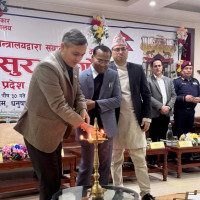- Thursday, 15 January 2026
Mindfulness
The Only Path Shown By Buddha
Buddha has taught many different things in his lifetime. His teachings depend on the audience and situations. However, if a novice curiously asks to summarise Buddha’s teachings in one word, what would it be? Certainly, it would be “mindfulness”.
In Buddhism, Ashtanga Marg or Eightfold Path is the path to liberation. In Ashtanga Marg, the seventh or second last is Samyak Smriti. After it, comes the final one – Samyak Samadhi. It means mindfulness leads to Samadhi which is the final destination of a seeker. The people who are looking for samadhi should practice mindfulness. There are no alternatives for liberation than mindfulness. That is why Buddha has called it ekayeno maggo, the only way to liberation from sufferings. When you hear it, you may feel that it is very narrow or limited. Yes, mindfulness is the only way, but the good news is that there are numerous ways of practicing mindfulness. You can choose the tools and techniques you prefer.

Certainly, mindfulness is practiced for spiritual liberation. However nowadays it is becoming popular among people from all walks of life. It is because scientific research has shown that the practice of mindfulness is beneficial for mental well-being and effectiveness in everyday life including at the workplace. That is why it is being adopted by professionals in health, psychology, management and education sectors as well. Since the results have been very impressive, its application is becoming more and more widespread. Here in this article, I will talk about the usage of mindfulness, in both practical life and spiritual progress.
Defining mindfulness
Before going into applications of mindfulness, first, let's understand what mindfulness is. The Sanskrit word for mindfulness is smriti (Pali = sati). Generally, we understand the meaning of smriti as memory. Besides, in a dictionary, you will find the words like recollection and flashback as meanings of smriti. None of these are the correct meaning of smriti as intended by samyak smriti. Here, smriti has nothing to do with the past. On the contrary, it means ‘awareness’ of the present moment. In a samyak smriti practice, you become mindful of what is going on in the present instant.

The word samyak is generally translated as right or correct. So, the meaning of samyak smriti becomes right mindfulness. Now you may ask if there is a right way, there must be a wrong way as well. That is a valid speculation. The opposite of samyak smriti is mithya smriti or wrong awareness. If right mindfulness is to dwell in the present, wrong mindfulness is to constantly dwell in negative thoughts. We know the mind at times occupies with automatic negative thinking. It is automatic because you have no control over it. Hence, you cannot stop it, although you know it is torturing your mind. Your mind might be bothered by some unpleasant events of the past or something negative that can happen in the future. In both cases, you are filled with negative emotions like anger, fear, greed, etc.
In the beginning, it is difficult to practice mindfulness because of the old habits of the mind to dwell in negativity or pleasure fantasy. Indeed, this is why we need to practice mindfulness meditation. At first, everything is difficult. But, by and by mind becomes calm and quiet. It is because the mind in the present does not require unnecessary thinking. Indeed, all the different techniques of mindfulness are to bring the mind to the present, which is the only reality out there.
Techniques of mindfulness
Mindfulness is discussed in detail by Buddha himself in Satipatthana Sutra – the sermon on the foundation of mindfulness. For a mindfulness practice, you can take anything that is going on in the present moment. The sutra prescribes mindfulness of breathing as the first technique. So, it is very popular that any teacher teaches a beginner to become aware of breathing that is constantly going in and out. It is not because there is anything special about breathing. It is because breathing is available to anyone at any time. Moreover, it is always going on in the present. As soon as you become aware of breathing, just after a few breaths, you will realize that your breathing starts to become longer and deeper. It is a sign that your mind is being peaceful. When the mind is peaceful, breathing automatically becomes longer and deeper. In stress, in fear, or in anger, we will find breathing short and shallow. Our breathing reveals all about our emotional states.
Broadly there are four foundations of mindfulness. The sutra has presented them in this order: mindfulness of the body (kayanupassana), mindfulness of feelings and sensations (vedananupassana), mindfulness of the mind (chittanupassana), and mindfulness of inner natures (dhammanupassana). In each foundation, again there are many objects of mindfulness practices. For example, above mentioned breathing meditation is a part of kayanupassana, mindfulness of the body. Besides, under kayanupassana, you can be aware of your body parts or walking, or movement of the body and many more.
The practice I like most is mahasati (great mindfulness). The practice is from forest monasteries in Thailand. In practice, people become aware of the movements of their hands. The practice has designed 14 hand movements in a beautiful series. The meditators keep on moving their hands in those 14 movements and become aware of the moves. The good thing about the practice is that it is done with open eyes. Mostly when I meditate with closed eyes, I am easily lost in thinking and imagination. Sometimes I feel bored and fall asleep.
By saying this, I am not pleading this meditation technique is better than others. Here, I am putting the fact that there are great many techniques of mindfulness practice. If one technique is not suiting you, there must be another technique that works for you.
Mindfulness has been much popularised by respected vipassana guru S. N. Goenka. Hundreds of thousands of people have attended camps by him and his students. I am very fortunate that I could join vipassana camp under the guidance of guru Goenka when I was only 17 years old. That was some four decades back. In his ten-day camp, firstly breathing meditation (anapanasati) is taught. From the fourth day to tenth day, vedananupassana or mindfulness of sensations is taught.
In fact, the body or sensations or mind, all are only objects for mindfulness practice. The objects are tools and practices are techniques. They are not the end. They should not be mistaken for mindfulness or meditation. However, we can talk of tools and techniques only. What a guru can give is also the methods. Howsoever powerful is a guru, he cannot give you mindfulness. That is what guru Goenka says repeatedly in vipassana camps, ‘You need to cultivate mindfulness by yourself. No guru can help you on it.’ You are your inner guru!
Mindfulness in modern day
In the latter half of the twentieth century, mindfulness was introduced to the West as a spiritual practice. Some scientists came in contact with it and began research on the impacts of mindfulness. One of the pioneers is Jon Kabat-Zinn. By profession, a professor of medicine, Kabat-Zinn learned mindfulness from Zen master Thich Nhat Hanh. He integrated mindfulness with scientific findings and introduced it to the health system. He presented mindfulness to help people cope with stress, anxiety, pain, and illness. His programme of mindfulness-based stress reduction (MBSR) has become so popular that medical centres and hospitals around the world have been offering it to clients and patients.
Further research proved the usefulness of mindfulness have been proved in improving emotional regulation and cognitive functions as well. So, now it is being used in schools and colleges, business organisations and sports. There is no area where mindfulness cannot be applied.
You may wonder how sitting silently and meditating can be of any use in business and sports. Certainly, the practice of mindfulness starts with sitting silently. But it is not limited to that. The real practice of mindfulness is in real life. You can apply mindfulness in communication, interacting with people, and managing stress and emotions. Professionals on physical well-being are using it in their weight reduction programs as well. That is through mindful eating!
It is encouraging that mindfulness is so relevant to modern-day people. However, there is also some negative side to its popularity. Anything that becomes much more popular becomes a business. Not much in Nepal, but in the West, mindfulness has become a huge business. Some professionals are qualified and serious in their practice. But some people are using it for attracting people easily. So, it is good to learn mindfulness, but with a proper guru than anyone in the marketplace.
(R. Manandhar has been a Buddhist monk for five years in Thailand. Later, he worked as a professional in senior management positions in international organisations. He is currently training managers on leadership and mindfulness.)
















